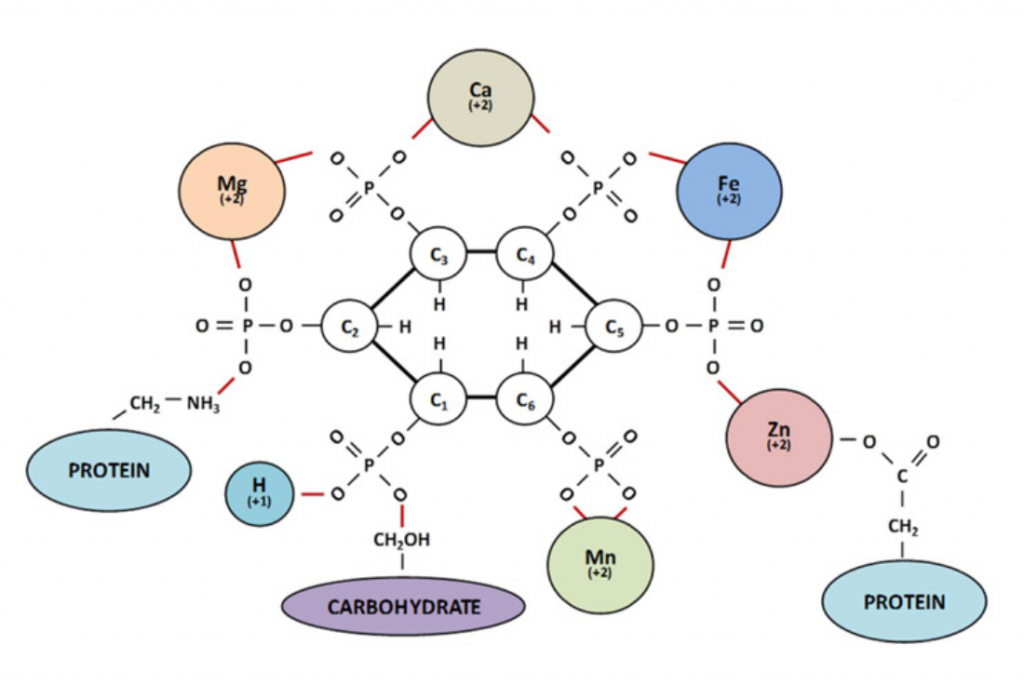> Animals
Phytate as a complexing agent
Phosphorus is the most expensive contribution in monogastric diets, after energy and protein. In plant seeds, P is mostly stored in phytic acid (myo-inositol 1,2,3,4,5,6-hexakis [dihydrogen phosphate] (InsP6)) and its salts. Certain plant-derived feed ingredients are particularly rich in phytate, for example oilseed and rapeseed meals, rice bran and wheat middlings. As pigs and poultry (like humans) are unable to hydrolyse InsP6 in the digestive process due to a lack of significant endogenous phytase enzymatic activity, the majority of P in plant-based diets is poorly absorbed.
InsP6 is bound to divalent cations such as calcium, iron, magnesium, manganese and zinc, in addition to proteins, carbohydrates and H+ ions.
Digestibility of feed phosphorus is typically in the 40-50 % range but can be improved to 60-80 % following the addition of exogenous phytase to the diet. Exogenous phytase enzymes of microbial or fungal origin have been added to monogastric diets since the 1990s. As InsP6 is found complexed to several divalent elements, the addition of phytase also shows “extra-phosphoric” effects by liberating calcium and trace minerals from the phytate molecule. The effect of phytase on the release of cationic trace elements is higher in piglets than in broilers, mostly due a higher pH in the stomach than in the gizzard. The effect of phytase on increasing the bioavailability of native trace minerals is higher with zinc than with copper : it has been shown in some pig studies in France that phytase could release zinc up to an equivalent of 20-35 mg/kg Zn.
Relationship between added amount of phytase activity and the amount of generated digestible Cu and Zn in pigs (International Phytase Summit, 2010).
To ensure phosphorus requirements are met, inorganic phosphate (iP) is routinely added to animal feeds, in the form of mono- or di-calcium phosphate (MCP or DCP) which are manufactured from naturally occurring phosphate rock. Meat and dairy are considered phosphorus-intensive protein sources. With the objective to prevent nutritional deficiencies which may impair not only farm productivity but also animal welfare, producers may oversupply the animal’s biological needs by excess of iP supplementation. Our ability to significantly reduce the usage of feed phosphates in animal feeds will be facilitated by :
- a more accurate definition of P requirements,
- developing technologies to recover from biomass P with high digestibility,
- selecting “low phytate” crops with high yields,
- selecting monogastric animals with greater ability to use indigestible P,
- using safe sources of animal proteins such as MBM,
- the widespread use of modern, affordable, and heat-stable phytase at high dosages,
- preventing excess calcium in complete feeds,
- supplementing calcium sources of high quality and trace mineral sources with slow dissolution kinetics and/or in monovalent form https://animine.eu/research-science-2/
- monitoring chloride dietary levels,
- studying interactions between mycotoxin binders and phytase,
- measuring the effect of phytase in ruminants.
Crisis on the availability and prices of phosphates force feed manufacturers to decrease P supplementation in the direction of precision mineral nutrition.


